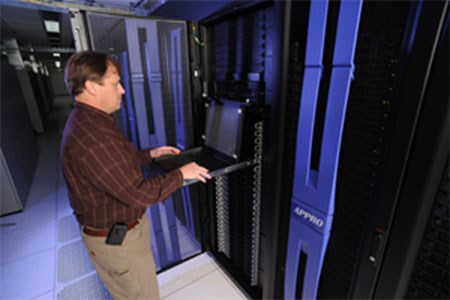The US Department of Energy (DOE) has announced a five-year funding renewal for the Consortium for the Advanced Simulation of Light Water Reactors (CASL), an initiative to develop advanced computing capabilities to model existing, operating nuclear reactors.
 |
| Idaho National Laboratories' Fission supercomputer provides computational support to CASL (Image: INL/CASL) |
CASL, based at the Oak Ridge National Laboratory, is an Energy Innovation Hub established in 2010 by the DOE and ten founding partners from academia and industry, including Westinghouse and the Tennessee Valley Authority (TVA). The $121.5 million of new funding from DOE will cover the next five years of operations, but is subject to congressional appropriations.
Over its first five years, CASL has worked to develop modelling and simulation tools to run on the world's most powerful computers and applying them to the current generation of nuclear reactors. The project has also created innovative methods for the interoperation of software that simulates many physical behaviours found in reactors, improving the accuracy of simulation results.
CASL's work is centred on the development of its Virtual Environment for Reactor Applications (VERA), which is designed to simulate the physical processes inside a nuclear reactor at unprecedented levels of detail and accuracy.
VERA has already been used to match actual startup data for a Generation 2 reactor on the grid (TVA's Watts Bar 1) and to predict startup data for a Westinghouse's AP1000 Generation 3+ reactor design. VERA's Core Simulator can follow reactor operations through a single refuelling cycle and is now working on demonstrating this for multiple refuelling cycles.
Over the next five years, CASL will work to extend VERA's application to other reactor designs including boiling water reactors and next-generation designs, such as small modular reactors. Plans include expanding VERA to address problems including fuel cladding performance under accident conditions, investigate chemically induced corrosive interactions between nuclear and nonnuclear materials and coolants, and to study fluid dynamics and heat transfer in both operational and transient scenarios for different reactor designs.
Announcing the funding, US Energy Secretary Ernest Moniz highlighted the priority placed on carbon reduction and climate protection in President Barack Obama's recent State of the Union address. "CASL's work to help further our understanding of nuclear reactors, improving safety while also making them more efficient, will help the transition to a low carbon economy," he said.
Energy Innovation Hubs are major integrated research centres, with researchers from many different institutions and technical backgrounds, modelled on the strong scientific management characteristics of past US-led initiatives that produced to major technological breakthroughs including the Manhattan Project, the Lincoln Lab at MIT that developed radar, AT&T Bell Laboratories that developed the transistor and the more recent Bioenergy Research Centers that pioneered advanced biotechnology techniques.
Researched and written
by World Nuclear News




_18570.jpg)
_16159.jpg)
_18938.jpg)
_33584.jpg)





